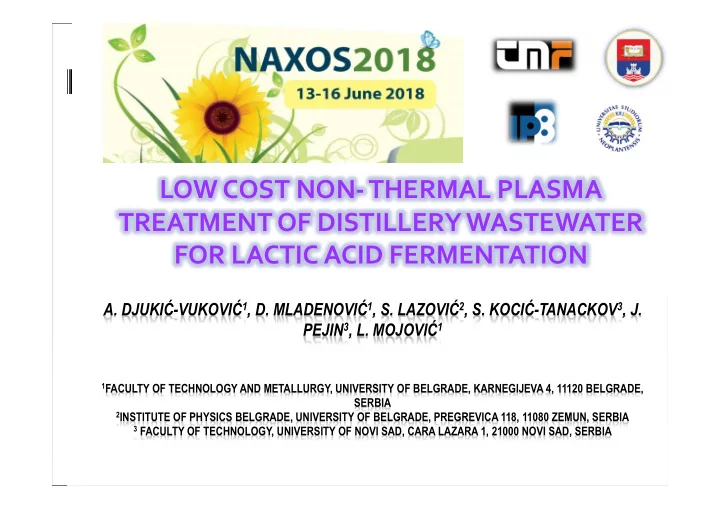

LOW COST NON ‐ THERMAL PLASMA TREATMENT OF DISTILLERY WASTEWATER FOR LACTIC ACID FERMENTATION A. DJUKI Ć -VUKOVI Ć 1 , D. MLADENOVI Ć 1 , S. LAZOVI Ć 2 , S. KOCI Ć -TANACKOV 3 , J. PEJIN 3 , L. MOJOVI Ć 1 1 FACULTY OF TECHNOLOGY AND METALLURGY, UNIVERSITY OF BELGRADE, KARNEGIJEVA 4, 11120 BELGRADE, SERBIA 2 INSTITUTE OF PHYSICS BELGRADE, UNIVERSITY OF BELGRADE, PREGREVICA 118, 11080 ZEMUN, SERBIA 3 FACULTY OF TECHNOLOGY, UNIVERSITY OF NOVI SAD, CARA LAZARA 1, 21000 NOVI SAD, SERBIA
Distillery wastewater from bioethanol production - stillage 1 L of bioethanol produced 20 L of stillage are remaining! Stillage composition Dry matter (%) 12.79 ± 0.31 Protein (g/L) 63.91 ± 2.81 Reducing sugar (g/L) 11.19 ± 0.83 Free –amino nitrogen (mg/L) 295.6 ± 1.5 Ash (g/L) 31.2 ± 0.1 Pollution: ↑ COD Stillage microbiota – ↑ BOD 5 susceptibility to contamination ... ► Has to be treated prior to disposal Mojovi ć , L., Pejin, D., Rakin, M., Pejin, J., Nikoli ć , S., & Djuki ć -Vukovi ć , A. (2012). Renewable and Sustainable Energy Reviews , 16 (8), 6040-6047.
AIM: Opportunities for application of non-thermal plasma in LA biorefinery processes “OPEN” ULTRASOUND FERMENTATION CLOSED “OPEN” NON-THERMAL STILLAGE STERILIZATION Fermentation LACTIC ACID PLASMA FERMENTATION FERMENTATION media ↑ Energy Maillard reaction PLA Lactobacillus Non convenient for rhamnosus ATCC 7469 large volumes – high stereoselective L- lactic acid strain - probiotic strain SPENT FERMENTATION MEDIA ANIMAL FEED Stillage – by-product from bioethanol WITH PROBIOTIC BIOMASS production on different feedstocks
Non-thermal or cold plasmas: ● lower pressures ● lower temperatures ● less energy intensive Non-thermal plasma generates: reactive species UV radiation electroporation of cells to lower extent Secondary Nitric oxide NO -• Superoxide anion O 2 generated active Peroxynitrite ONOO - Hydrogen peroxide H 2 O 2 species Dinitrogen trioxide N 2 O 3 Hydroxyl radical • OH Media subjected to → “etching” surfaces plasma treatment → ↓ pH value of media (H 3 O + ) Applications: • To inactivate undesired microbiota in substrate? In stillage microbiota: Gram (+) bacteria – lactic acid bacteria - desired Gram (-) bacteria – undesired
Materials and methods Non-thermal plasma Non-thermal Non-thermal plasma plasma generated UV o Plasma needle operating at 25 kHz in ambient air. o Argon was used as a feed gas (2 slm flow rate) in order to reduce the breakdown voltage through Penning ionization. o The operating power was 2 W. o The distance between the jet and substrate UV + reactive species UV was 1 cm. High-power ultrasound Ultrasound sonotrode (TT 13 mm , Bandelin, Germany), 20 kHz, 200 W Volume of sample 60 ml
NON-THERMALPLASMA TREATMENT IN BIOREFINERY PROCESSES Results Two model microorganisms treated by non-thermal plasma in sterilized water and stillage: Lactobacillus acidophilus – Gram (+) bacteria – representative of LAB Escherichia coli – Gram (-) bacteria L. acidophilus E. coli L. acidophilus E. coli L. acidophilus E. coli L. acidophilus E. coli 0 UV Total -1 inactivation LogN/N 0 reduction by plasma ROS, RNS -2 -3 • E. coli is more susceptible to plasma -4 treatment than L. acidophilus ... Water Stillage -5
NON-THERMALPLASMA TREATMENT IN BIOREFINERY PROCESSES Number of viable cells of stillage microbiota in time after different treatments untreated • 24h after treatment no significant 8 increase in the number of bacteria logN (CFU/ml) • 3 log unit lower number of viable ultrasound cells than in untreated sample 6 plasma 4 0 1 2 20 21 22 23 24 25 Time (h) Longer storage time for stillage Versatility in utilization – for different revalorization strategies
NON-THERMALPLASMA TREATMENT IN BIOREFINERY PROCESSES Effect of treatments on growth of LA producing microorganisms and LA production Lactobacillus rhamnosus ATCC 7469 – high L (+) LA strain Untreated, LAB 10 Sterile, LAB Ultrasound P 30min, LAB 35 Sterilization US 10 min, LAB Plasma Lactic acid concentration (g/L) 30 L1 8 25 Untreated logN (CFU/ml) 20 15 6 10 5 0 4 0 12 24 36 48 24 1 Time (h) Time (h) Stereoselectivity? The growth of microorganisms was closed LAF - 97.2% of produced LA was L (+) isomer not affected by previous plasma Plasma treated, open LAF - 95.5% L (+) isomer treatment.
NON-THERMALPLASMA TREATMENT IN BIOREFINERY PROCESSES Estimate of required energy for different processes at laboratory level and mass of LA produced 315 kJ 100 • Highest in LA production 80 • Lowest in energy consumption Relative % 60 40 90 kJ 20 36 kJ 0 Sterilization 20min UT 10min PT 30min
NON-THERMALPLASMA TREATMENT IN BIOREFINERY PROCESSES Conclusions Non-thermal plasma treatment could decrease the number of microorganisms in media and improve overall performance of LAF on stillage Plasma treatment has shown selectivity towards G (-) bacteria. Plasma treatment resulted in the highest LA productivity (20% higher than with ultrasound treatment) and lowest energy consumption - in “open” fermentation. Stereoselectivity of L(+) LA was maintained.
ACKNOWLEDGMENT This work presented here was funded by the Serbian Ministry of Education, Science and Technological development (TR 31017). Thank you for your attention! CONTACT Aleksandra Djuki ć -Vukovi ć Faculty of Technology and Metallurgy, University of Belgrade Serbia adjukic@tmf.bg.ac.rs
Recommend
More recommend